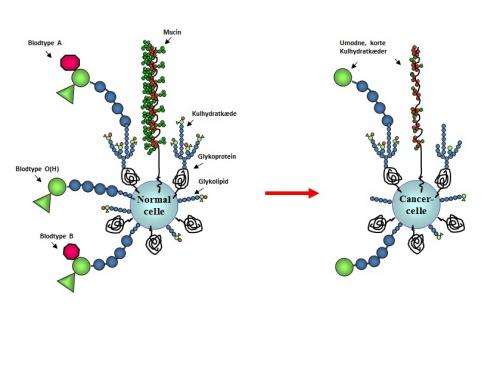Sugar molecules on the surface of cells change their characteristics during development of cancer. Normal cells, as shown on the left, typically have long chains of sugar molecules (illustrated by circles filled with different colours and with the protein, that the chains are attached to, illustrated as a black line) that end in our blod type antigen like ABO. Cancer cells, on the contrary, often have truncated, immature chains of sugar molecules, as shown on the right. Credit: University of Copenhagen
The process of glycosylation, where sugar molecules are attached to proteins, has long been of interest to scientists, particularly because certain sugar molecules are present in very high numbers in cancer cells. It now turns out that these sugar molecules are not only present but actually aid the growth of the malignant cells. In the long term this discovery is an important step towards a cure that can stop the growth of cancer cells.
In co-operation with a research group from Singapore, scientists at University of Copenhagen have shown that immature sugar molecules in the form of truncated O-glycans aid growth properties of cancer cells. Previously, scientists have not been able to decode the significance of these truncated O-glycans, and therefore, the results, which were recently published in the journal PNAS, represent an important contribution to understanding the growth of cancer cells as well as the work towards developing a cure that can limit or stop the growth.
Catharina Steentoft, PhD student at Copenhagen Center for Glycomics and one of the scientists behind the results, stresses that this is basic science and there is still a long way from the results to actually developing a treatment or using them for diagnostic purposes. The results are still a cause for optimism, though.
"This is part of how we will proceed in the battle against cancer. When you know a certain process is important for the development of cancer you can start to consider ways to affect this process in a way that stops the cancer cell from taking advantage of it," explains Catharina Steentoft.
Sugar molecules affect proteins
Sugar molecules play an important role in almost all of the processes taking place in the body. One of the ways in which sugar molecules affect us is through glycosylation, a process where sugar molecules are attached to proteins. The proteins are basically the building bricks of the body, whilst sugar molecules affect the proteins, and therefore play a significant role in the human organism. A flaw in a chain of sugar molecules can lead to protein malfunctioning and disease.
As early as 1982, scientists around the world realised the importance of sugar molecules for cancer. The American doctor and scientist Georg F. Springer discovered that a certain type of sugar molecules, the truncated O-glycans, were particularly prominent in cancer cells. The discovery of Catharina Steentoft and colleagues builds on the foundation of this knowledge.
Pinpointing ways to proceed
For 30 years, scientists all over the world have worked on using the truncated O-glycans as biomarkers for diagnostics and outcome-prediction, but now the group of researchers from Singapore and Copenhagen has finally pinpointed the significance of these sugar molecules – that they actually cause the cancer cells to grow and the cancer to spread more aggressively.
"We have now taken the first step towards understanding how cancer cells can change their glycosylation and produce these truncated O-glycans. It is a rather big step forward since it gives us an entirely new understanding of something we have worked many years to grasp. It guides our entire field of research towards new ways to proceed in the battle against cancer," Catharina Steentoft says.
Facts about sugar
Researchers agree that the significance of sugar molecules for living organisms is huge, but so far there is not a lot of knowledge about the whys and hows. For that reason, Copenhagen Center for Glycomics was created in 2012 headed by professor Henrik Clausen. Catharina Steentoft and her co-workers at the center study what is known as the third language of life (genes being the first, proteins being the second), the sugar molecules that coat the surface of proteins and cells.
More information: www.ncbi.nlm.nih.gov/pmc/articles/PMC3752262/
Journal information: Proceedings of the National Academy of Sciences
Provided by University of Copenhagen





















